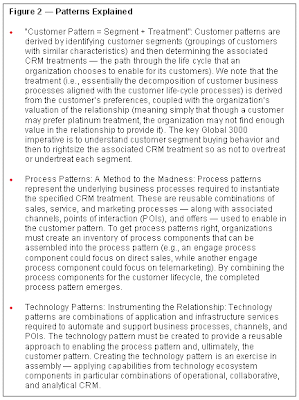Segmentation is the Key to Customer Psychology
Truly Make the Customer the CRM Design Point
Ms. Liz Roche
Managing Partner, Customers Incorporated (US)
This article is exclusively written for GCCRM.
Product placement! Lifestyle marketing! Integrated promotions! It seems that everywhere you look these days some marketer is trying to get you to buy a product by appealing to your psyche rather than explicitly advertising it. As technology continues to pervade our daily lives, the lines between sales, marketing, advertising and entertainment are rapidly blurring. The big payback for marketers is to get into your head and influence your behavior by augmenting traditional marketing and advertising with an appeal to your psyche.
But here's the rub: all customers are not created equal and as such it's not so easy to understand what actually drives purchasing behavior. Indeed Business Week recently ran a cover story on the psychology of the male consumer (Business Week, 09/04/06, Revealed! Secrets of the Male Shopper). But certainly not all consumers are men. And not all consumers purchase all products. And even if you have a handle on who purchases your product, not all customers are equally valuable (profitable + strategically important). As such, the key to effecting behavior via customer psychology is rock solid customer segmentation.
Customer segmentation is the key to making the customer the CRM design point, leveraging CRM effectiveness (doing better things), as opposed to simply implementing operational technology (e.g., sales automation) that largely addresses efficiency (doing things better). At its most basic level, segmentation involves classifying customers with similar characteristics into groups (called "segments") and then dealing with the segments instead of individual customers (especially important in organizations with large customer bases, where individual customer scrutiny would be virtually impossible). The key reason for segmentation is the development of informed, segment-specific customer lifecycle treatments as well as a better understanding of which industries and markets should be served and which should be lowest priority going forward. Most important, segmentation guides future interaction with customers, based on the organization's deeper understanding of each segment's (and, by inference, each customer's) profitability, behavior, industry context, and lifetime value. Companies also use segmentation to prioritize new product development efforts, develop customized marketing programs, choose specific product features, establish appropriate service options, design an optimal distribution strategy, and determine appropriate product pricing.
Customer segmentation begins with the identification and collection of pertinent data elements (classification variables) and assumes that IT and marketing professionals will work closely together in data gathering strategies:
. Financial: Revenue generated from the customer (transactions), cost to acquire and retain the customer, customer's credit worthiness, resulting profit from the customer, and interactions (cost to serve).
. Demographic: Describing customers in terms of their personal characteristics, such as age, sex, income, ethnicity, marital status, education, and occupation.
. Geographic: Describing customers in terms of their physical location, such as city, state, ZIP code, Census tract, county, region, and metropolitan/suburban/rural location.
. Psychographic: Describing customers in terms of personality traits, such as attitudes, lifestyle, aversion to risk, and TV programs watched.
. Behavioral: Emphasizes what customers have purchased and can suggest what other products they may be interested in; this includes brand loyalty, usage level, benefits sought, and distribution channels used.
When customer segments have been developed, a CRM treatment (customer pattern) can then be developed to ultimately create exit barriers and gain channel efficiencies along the way. However, there is a "chicken or the egg" information conundrum: most organizations do not have enough information to profile their customers, though designing around the customer requires information to create customer patterns. This can be a vicious circle - and avoiding this conundrum means that even without perfect information, organizations must start somewhere and use that as an opportunity to collect information along the way, updating the segment/ treatments iteratively.

What Is the Right Number of Segments to Have?
There is no definitive answer. Experience, intuition, statistical results, and common sense all must be applied to decide on the number of segments to retain. If there are numerous very small segments, the segmentation criteria may need adjustment. Too many segments can lead to the development of too many different (i.e., expensive) marketing programs for small, very similar markets. However, several rules of thumb can be used to determine the appropriate number of segments. Segments must be:
. Large enough: The majority of segments must be large enough to be economically feasible to support marketing and product design efforts.
. Relevant: The segments must be relevant to the company's products/services.
. Reachable: Segments must be reachable through one or more marketing mix variables (price, promotion, features, and distribution).
. Differentiable: Clearly defined differences among customer segments must exist to make some segments more desirable than others.
Although determining a segmentation strategy is very much a business issue, technologies can be brought to bear to make this task somewhat easier:
. Data mining/behavior modeling: Predictive analysis technologies built into campaign management tools can help marketers move from declarative segmentation (segmenting based on database fields) to predictive segmentation (segmenting based on mathematical algorithms), enabling more "creative" segmentation.
. Optimization: Technologies providing nonlinear, constraint-based optimization enable mathematical calculation of best customer/segment, best offer, and best campaign.
As we have seen, organizations must understand customer psychology to truly make the customer the CRM design point. This notion is enabled by creating value-based customer segments and applying appropriately "sized" CRM life-cycle treatments.
source: http://www.greaterchinacrm.org:8080



